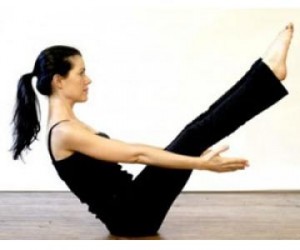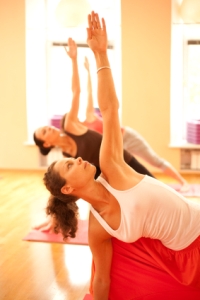 In 1997, certified Pilates instructor Jonathan Urla combined yoga postures and Pilates exercises and named it Yogilates. Louise Solomon created her own blend of both and termed it Yogalates. Whatever you call it, hybrid classes like these are very popular in health clubs and studios across the country.
In 1997, certified Pilates instructor Jonathan Urla combined yoga postures and Pilates exercises and named it Yogilates. Louise Solomon created her own blend of both and termed it Yogalates. Whatever you call it, hybrid classes like these are very popular in health clubs and studios across the country.
Yogilates and other hybrid yoga and Pilates workouts are designed for the purpose of gaining the benefits of core work from Pilates while mixing in the breath and flexibility training of yoga. Just as a yoga practice may not target all of the core muscles, a Pilates class may overlook certain stretches that promote a balanced and healthy body. Combining the two introduces a dynamic experience of connecting the breath with a new level of mind and body fitness.
Save Time
Many of us are hard pressed for time to set aside an hour a day to exercise. Rather than taking a Pilates class and then trying finding the time to follow it up with yoga, we can be efficient and take both at once!
Cross Train
Hybrid classes are also attractive to those who need a little variety in their workouts. Incorporating core work with yoga poses is a superb way to break out of the usual routine. Changing up the sequencing, challenging the muscles in new ways and adding an element of flexibility can turbo charge your body for lasting results.
Reduce Injury
 Doing the same workout over and over can put you at risk for overuse injuries. Stretching without strengthening can put undue stress on your ligaments and joints just as too much muscle work can tighten the body, leaving it vulnerable to tears and strains. Yogilates offers a balance between strength and flexibility that is not repetitive or monotonous.
Doing the same workout over and over can put you at risk for overuse injuries. Stretching without strengthening can put undue stress on your ligaments and joints just as too much muscle work can tighten the body, leaving it vulnerable to tears and strains. Yogilates offers a balance between strength and flexibility that is not repetitive or monotonous.
Better Posture
Abdominal exercises can be addictive. It is not uncommon for health nuts to crank out 100 crunches and pay no mind to the opposing muscle groups of the back. This can lead to muscle imbalances that could affect your body’s ability to stand up straight. The Pilates part of Yogilates honors all the muscle of the core, not just the often over-emphasized abdominals.
In addition, many of us are stiff from spending a lot of time sitting, whether it is from driving or working at our computers. The yoga side of Yogilates addresses our modern day lifestyle and offers the perfect poses to efficiently stretch and lengthen those muscles in need without over doing it.
What to Expect
Your yoga mat doubles as a Pilates mat and vice versa, and you will need it for class. Wear stretchy, comfortable clothes that you would normally wear to a yoga or Pilates class and leave your shoes at the door.
Depending on the instructor, you may begin with some Pilates based warm up exercises or gentle yoga poses. Either way, you will ease into the workout slowly, which makes it appropriate for beginners or those with stiff bodies.
Throughout class you will learn to engage your core, stand up straight and breathe in a whole new way. At the end of class you will leave feeling light and refreshed, with an extra hour in your day!
Also Read:

